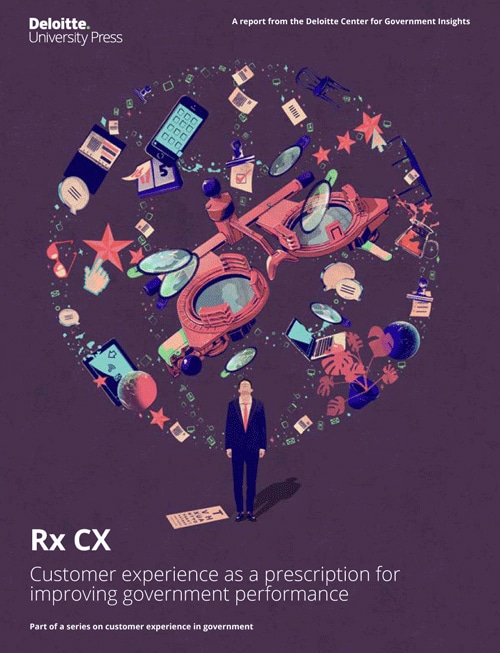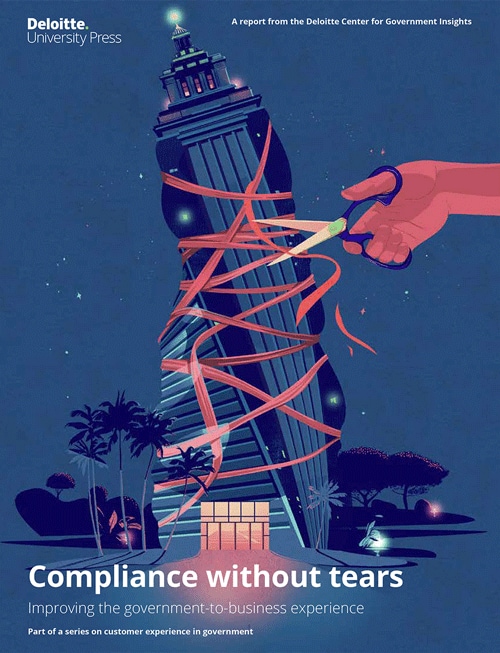Emerging trends: Five trends reshaping state government has been saved

Emerging trends: Five trends reshaping state government The State Policy Road Map: Solutions for the Journey Ahead
07 February 2018
Technologies such as artificial intelligence and cognitive computing can offer big opportunities as well as challenges. From blockchain to human-centered design, states should think ahead to try to make the most of these emerging trends.
1. Artificial intelligence: Redesigning public sector work
Until recently, the primary function of computers was to process information—that is, to take structured inputs, perform manipulations, and produce outputs. Computers ran payroll, helped to process applications, and performed spreadsheet-like calculations. Computers offered fast, error-free processing of data.
Learn more
View the full collection
Subscribe to receive Public Sector content
View the table of contents and create a custom PDF, or download the full collection
Sign up for the webcast
How quaint.
Today, artificial intelligence (AI) and cognitive computing are vastly enhancing the power of computers to produce value. Computers can now accept inputs in the form of unstructured data—everything from handwritten notes to videos—and make sense of them through techniques such as image and facial recognition. In terms of processing, computers no longer need to follow a set of hard-coded instructions. Thanks to machine learning, computers can use feedback to “program themselves” adaptively. The result is nothing less than astounding, as AI is starting to emulate certain kinds of human intelligence—everything from driving a car to playing poker to providing medical diagnoses to suggesting songs you might like based on what you’ve listened to in the past.
What will AI mean for state government? And what will it mean for state employees?
While some fear that AI-based programs will be a job-killer for state employees, a more likely scenario—particularly in the near term—may be that cognitive technologies will free up employees from dull, dangerous, and repetitive tasks, and augment their ability to perform higher value-added work. The ultimate result should be better, faster services for citizens—particularly in service areas with big backlogs.
How much can be saved through AI and how quickly largely depends on the amount of investment made in this area. A Deloitte study found that, with strong support for adoption of automation and AI applications, states could expect 27 to 30 percent time savings within five to seven years.1 To realize an impact of this extent will require investment in technology as well as rethinking many aspects of state government work.
Many state governments are already experimenting with AI-based applications to improve services. Take, for example, the Georgia Government Transparency and Campaign Finance Commission, which processes about 40,000 pages of campaign finance disclosures per month, many of them handwritten. After evaluating other alternatives, the commission opted for a solution that combines handwriting recognition software with crowdsourced human review to keep pace with the workload while ensuring quality.2
Explore Deloitte’s Artificial Intelligence in Government collection for a deeper dive in this area.
2. Blockchain: A digital ledger with a difference
Blockchain is complicated. Known primarily as the technology that supports bitcoin and other cryptocurrencies, blockchain wasn’t even on the radar of most state leaders as recently as a few years ago.
That is rapidly changing. In July 2017, Delaware enacted legislation that allows corporations to use blockchain technology to maintain a record of stock ownership and voting rights. The law allows these important ledgers to be maintained via “distributed electronic networks or databases,” which presumably would include blockchain.3 This could have a significant impact, as over 66 percent of publicly traded companies in the United States are incorporated in Delaware.4
Though a leader in blockchain, Delaware is not the only state experimenting with it. New York, Illinois, and Texas have followed suit and are piloting and/or testing blockchain applications.5 For its part, the private sector, particularly the financial services industry, is seeing significant investment in blockchain. A 2016 estimate suggested that banks alone would invest more than $200 million in blockchain in 2017.6 Some have likened blockchain’s game-changing potential to that of the Internet, particularly in terms of financial transactions.
Many states, while intrigued by blockchain, aren’t sure of how to capture its potential benefits to security, efficiency, and speed.
To get a better sense of blockchain’s potential for government, think transactions. Blockchain is a ledger—a distributed, consensus ledger. Organizations have traditionally recorded transactions in ledgers kept under lock and key. Those ledgers are typically isolated to protect their accuracy and sanctity, and when conducting business, each organization maintains its own separate record to independently verify information.7
 Read more about blockchain basics for government in the Deloitte study Will blockchain transform the public sector? |
Creating distributed trust through a collectively agreed-upon consensus protocol is potentially transformative, freeing the ledger from the constraints of isolation in much the same way as the World Wide Web freed information and communications, transforming the way we do so much in business, government, and our personal lives.
Identity management, licensing and registration, land registration, and voting are just some of the potential use cases where governments are exploring blockchain.
3. Human-centered design: Putting people first
Frustration is a powerful emotion. Too often, even if the underlying technology works, a citizen can be frustrated by a government interaction that fails to create a smooth, intuitive experience. Whether it is a complicated tax form, the need to give the same data to five different agencies, or a confusing website, a poorly designed interaction can leave citizens dissatisfied with the service they receive.
Thankfully, the field of human-centered design combines elements of technology and design to improve the citizen experience.
Historically, most state governments haven’t focused much attention on customer experience (CX). But in the digital age, citizens intuitively compare their interactions with government with the experiences they have with the best online retailers. When government experiences don’t match expectations, frustration ensues.
Human-centered design focuses on the preferences of the user/citizen. Rather than requiring users to adapt their behaviors to a tool, a human-centered system supports existing behaviors. It involves a deep understanding of customers’ needs—both the ones they tell you about and, perhaps more importantly, the ones they don’t.
State governments can face some pretty daunting design challenges, as consequential as any in government, making human-centered design principles sorely needed. How can states move forward on this front?
The first step is to recognize that human-centered design is a critical discipline, and that driving changes in the citizen experience requires executive support. Senior state leaders should provide a mandate for change, and the resources needed to drive agencywide improvements. It’s important for someone—be it a chief customer officer or a CX council comprising leaders who collectively own all the touchpoints across the citizen/business journey—to have a horizontal view across the entire agency and take responsibility for ensuring that the experience is consistent across touchpoints that may span multiple business units.
Read more about how human-centered design can improve the citizen experience: |
|
 Rx CX: Customer experience as a prescription for improving government performance |
 Compliance without tears: Improving the government-to-business experience |
4. Nudge thinking
The idea is simple: It is better for state and local governments to help citizens “do the right thing” in the first place than to go through the painful process of penalizing those who misbehave. Government agencies seek to promote socially desirable citizen behaviors in many ways. No doubt the carrots-and-sticks paradigm—incentives and punishments used to change behavior—has its place. But for more minor offenses or oversights, trying to drive better social outcomes through punitive actions can be costly, and officials are rightly reluctant to unleash big-time punishments on small-time violators.
Enter the emerging field of behavioral science, which explains how nudges—carefully designed prompts and activities that encourage better outcomes by leveraging how people naturally think and feel—can be a more effective (and often less expensive) alternative. A stark departure from the traditional carrots-and-sticks approach, nudge thinking relies on the idea that small changes to the choice environment can encourage large changes in people’s actions. Part of the appeal of nudges—for both those seeking change and those who are being asked to change—is that, instead of mandating behavior, nudges offer people the ability to make their own decisions.
 Read more about how nudges can help state government yield better results using fewer resources in Beyond carrots and sticks. |
There are many areas where nudge thinking may prove more effective—and potentially much more cost-effective—than the carrots-and-sticks approach. And yet most state and local governments are just beginning to scratch the surface of this approach. They have not fully explored or realized its potential benefits, both in terms of cost and outcomes. Three broad areas in which state governments and municipalities could apply nudge thinking are in increasing program compliance, improving program adherence, and promoting better choices in participants and encouraging better behaviors.
5. Organizing for transformative change
The tech tsunami that is transforming our world creates a situation where state governments are often faced with more change than they are set up to handle. That is because the traditional silos of services are focused on delivering services—not driving change.
In response, some states are looking at establishing teams, sometimes led by a chief operating officer, that are designed to drive enterprise-wide transformations. In just the past few years, Tennessee, Missouri, and Oregon have established COO positions, and interest in the role appears to be growing.8
Whether done under the guise of a COO or another title, successfully organizing for transformative change in state government entails several factors. Some of the most important include:
- A focus on driving change: The various secretariats of state government generally have their hands full running their operations. As a result, they often don’t have the bandwidth to drive change. A transformation tiger team wakes up every day focused on driving innovation.
- Cross-boundary authority: Issues such as the opioid crisis impact law enforcement, health, social services, and more. To drive change on an ecosystem problem, governors need someone with the authority to work across departmental boundaries. Ditto for change initiatives such as identity management.
- A team with the right skill set: The skill sets needed to drive deep organizational change include project management, digital design, data analytics, change management expertise, and others. No individual department could afford permanent staff skilled in these disciplines, nor could they keep them continuously busy. Hiring contractors and consultants is one way to address this talent deficit. Another option is to establish a centralized unit staffed to support innovation that could address projects on an as-needed basis, such as for large procurement projects or enterprise-wide change efforts—or just to supply added firepower in addressing a governor’s top priority.
- Corner-office support: A bedrock principle of enterprise-wide transformation initiatives is executive support. A COO or another senior executive has the visible support of the governor and access to the corner office to resolve roadblocks.
- An outsider’s perspective: Sometimes it is easier to see opportunities for change from the outside. For example, the state of Washington’s “Results Washington” office promotes and uses the tools of lean management and performance measurement to drive (and measure) improvements throughout the state government. Having a group outside an agency or department’s chain of command can help provide both the skills and the objectivity to effectively drive change.





